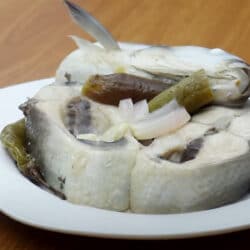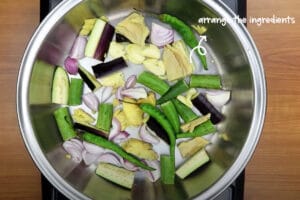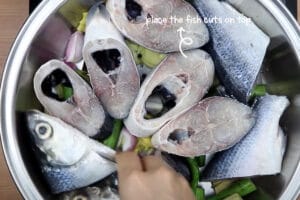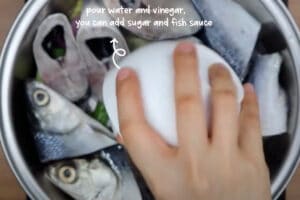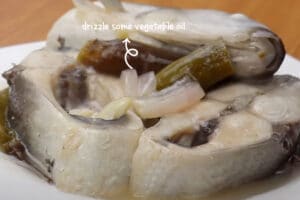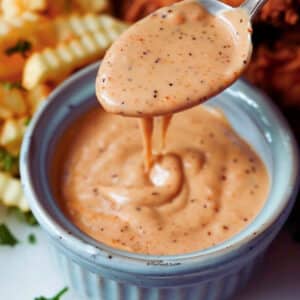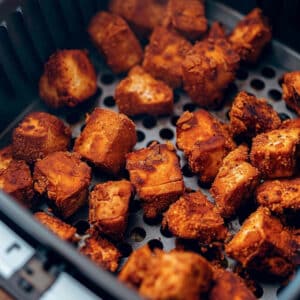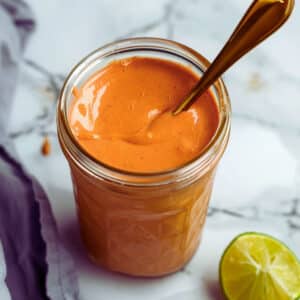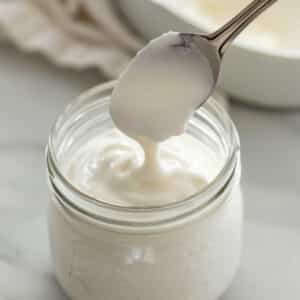Thinking about cooking bangus or milkfish is super easy. I'll show you how to cook paksiw na bangus; just follow the step-by-step instructions in the pictures below.
Paksiw na bangus, or stewed vinegar milkfish, is a popular dish in the country. Filipinos are proud of this fish because the Philippines supplies about 55 percent of the world's bangus. The tasty belly fat and the sweet, white flesh are unique to the bite. The only downside is its bony structure.
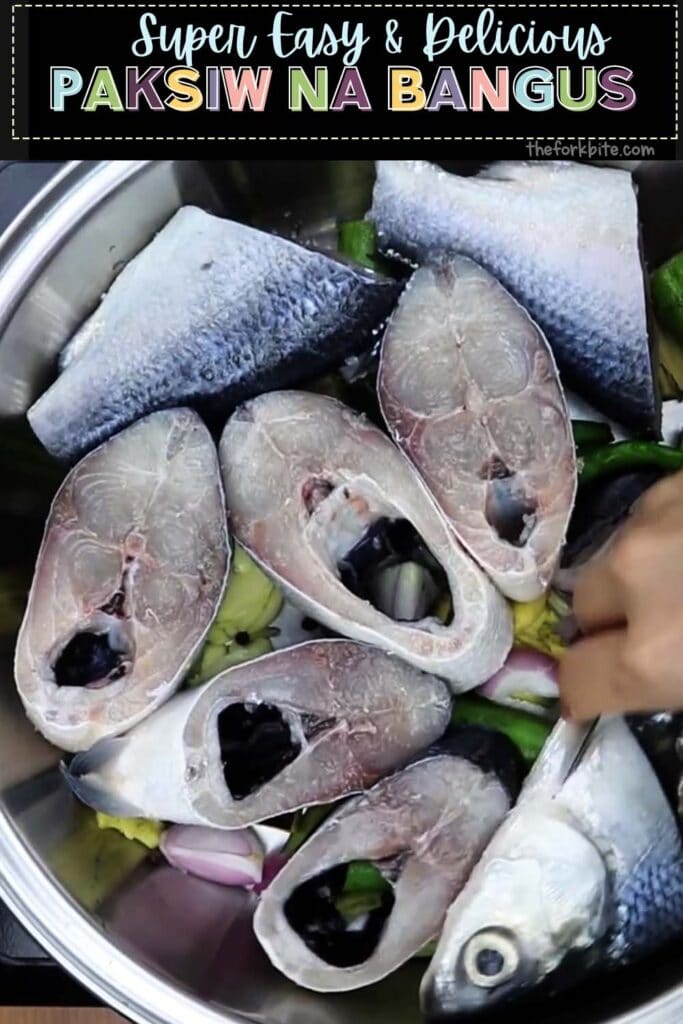
The first time I tried this dish, I would take the sour, spicy sauce and pour it over my bowl of steaming rice. It's best to pair this dish with bitter gourd or ampalaya.
Now, paksiw na bangus is one of my favorites. To better understand this dish, let's take a look at the star ingredient—the bangus or milkfish.
What is Bangus?
Milkfish known as "bangus" or 虱目鱼 (Shī mù yú) is a popular type of fish in the Philippines and Taiwan. Many people in other parts of the world do not like this fish because it has too many bones.
The spines alone have 214 bones or thin spines in bundles. The good news is, it is easy to remove as you can pull out the entire spine and not individually.
The one-of-a-kind structure of the bangus or milkfish allows fishmongers to debone it with unbelievable speed and accuracy. That is why there is the boneless bangus, which many love.
Boneless bangus is ideal for frying. For paksiw na bangus, using the bone-in kind is perfect.
Cooking:
I like cooking milkfish with the skin on it. Its flesh cooks firmly while the skin often shrinks during cooking.
A mature bangus can be very big, typically used for "rellenong bangus" or stuffed bangus. It is also ideal for paksiw na bangus, but you must slice it into workable pieces. Baby bangus is fried whole.
Dusting the bangus with rice flour can keep the skin intact and separate from the frying pan. Without this flour barrier, the skin will stick to the turner or the bottom of the pan. It peels off and then makes a total mess.
The Scales

These scales cover the bangus entirely; you cannot pull them off; hence, you need a fish scaling tool.
Wearing gloves is ideal when doing this part of the prep. Expect the scales to fly all over when scaling milkfish or bangus.
So, what is paksiw?
"Paksiw" does not have a direct English translation. It can still be a term to describe the Filipino cooking method of simmering meat in some vinegar.
The vinegar will need ginger, garlic, salt, chilis, and peppercorn. The result is a tangy, spicy flavor.
I can say that Paksiw is similar to adobo. The longer it sits, the tastier it becomes. I always cook it and then wait until the next day to eat it. You will notice the bolder taste.
There are other variations of paksiw.
There is paksiw na isda (fish) and paksiw na baboy (pork). These need different ingredients, but the broth or sauce remains the same. Serving it with rice on the side is ideal.
The most well-known paksiw dish is paksiw na bangus, a dish cooked in vinegar with spices. The entire process of preparing and cooking will take about 30 minutes. Milkfish does even need to simmer for hours.
What is paksiw na isda?
"Paksiw na isda" is basically fish poached in a spiced vinegar broth.
The main seasoning is fish sauce, and then the main spice is siling haba (or green chili). The most common vegetables for this dish are eggplant and bitter melon or ampalaya.
What is the English word for paksiw fish?
Some people call it boiled, pickled fish. The term "paksiw" originates from the Visayan verb "un-on" or "un-un". It means "stew something with salt, spices, and vinegar."
The different types of paksiw
This method of cooking refers to the different dishes cooked in vinegar broth.
This is a common variant of the dish called ginataang isda. It has vinegar to make the broth sour. This dish combines "paksiw" and "ginataan" Filipino cooking methods.
1 Inun-unan
Also called "inun-unan". It is the Visayan version of paksiw na isda.
This dish uses spices like "siling haba" or green chili, pepper, salt, onions, and ginger. This type of paksiw is not like the northern version.
Its name means stew with vinegar, spices, and salt. It does not have little or no water added to the vinegar. There are no vegetables either; it is sometimes called boiled pickled fish. You can find the recipe here.
2 Paksiw na baboy
This type of paksiw has pork. People who make this recipe often use "pata" (shank or pork hock). The cooking process is like that of adobo.
But it has banana blossoms, pineapples, and sugar. It also has water to moisten the meat and produce a rich gravy or sauce. You can find the recipe here.
Read: Binagoongan Baboy Recipe (Pork Braised in Shrimp Paste)
3 Paksiw na dilis
This is a unique variation. Paksiw na dilis uses anchovies (Bolinaw in Visayan and dilis in Tagalog). It is wrapped in banana leaves. That is why it is called pinais na bolinaw or inun-unan na bolinaw. Check the recipe here.
4 Paksiw na isda
Learning how to cook paksiw na isda is not as difficult as it sounds. You will poach the fish in vinegar. Then, the seasoning will be fish sauce. The spice will be siling haba. It often includes vegetables like bitter melon or ampalaya in Tagalog.
5 Paksiw na lechon
"Paksiw na lechon's" main ingredient is leftover lechon or roasted pork.
The meat will cook in garlic, water, onions, black pepper, and vinegar. The version in Luzon adds a liver spread, ground liver, or lechon sauce, and it does not have these additions to the Visayan version. Super easy recipe here.
Tips and Techniques for making the paksiw
- It is a versatile recipe to add whatever vegetables you like.
- If you do not like the long chilis, you can omit them.
- Adjusting the amount of vinegar will give you different levels of sourness and flavor.
- You can choose the best type of vinegar you want for this dish.
- You can use another type of fish if you cannot access bangus or milkfish.
- Remember to use stainless steel or clay pots for this dish. Avoid aluminum ones. Vinegar is an acid. It could corrode the aluminum pot.
How to get rid of the fish aftertaste?
Unfortunately, some people dislike fish. The fishy aftertaste and odor are a turn-off.
The main reason is that you should still know how to clean your fish of choice. You cannot remove all of the fishy aftertastes.
But you can reduce it by following these steps:
- Washing the milkfish multiple times under tepid running water is essential in preparing the fish.
- Then, it would be best to pour a cup of vinegar and a handful of salt over the cleaned fish.
- Massaging the salt and vinegar solution into the fish will help remove its fishiness.
Allowing the fish to marinate in the solution for about 10 minutes and then rinsing the fish again under running water is an effective way to remove the fishy aftertaste and odor.
Note:
This is an optional method: I usually add soy sauce instead of water to give the sauce some color and fruitiness. This recipe also has more water because I wanted to simmer the fish for several hours on low heat.
This process allows much water to evaporate until only a cup is left. You can opt to use a pressure cooker.
Step-by-step instructions: How to cook paksiw na bangus
Learning how to cook paksiw na bangus is a plus on your list of kitchen skills. This will help you produce a delicious fish dish in no time.
Step 1 Clean the bangus well.
If you're pressed for time, you can ask your fishmonger to perform this crucial part of the recipe. The skilled and experienced fishmonger can de-scale, cut, and de-gut your chosen fish.
Step 2 Remove the gallbladder from the inner belly

- This is essential. You can use the pointed part of your knife to accomplish this process. This gallbladder gives an unpleasant taste to the dish. Gently take it off and be cautious not to break it.
- Rinse the fish thoroughly and rub it with salt all over. Rinse with cold running water.
- Slice the fish diagonally (about 5 pieces).
Step 3 Placement of ingredients
Arrange the other ingredients first ( place them at the bottom of the pan) to prevent overcooking the fish.

- 1 large bangus (milkfish) scaled and diagonally sliced into 5 to 6 slices
Other ingredients:
- 3 thumbs ginger crushed
- 5 cloves crushed garlic
- 1 big onion sliced
- 2 bay leaves
- 3 pcs green chili
- 3 pcs okra chopped
- 1 eggplant chopped
- Bitter melon (optional)
- 1 cup water
- ½ cup white vinegar
- 2 tablespoon fish sauce
- 1 teaspoon whole peppercorns
- 1 or 2 tablespoon sugar (optional)
- 2 teaspoon vegetable oil (drizzled on top of the dish after the fish is cooked)
Then, place the fish cuts on top of the ingredients and sprinkle ½ a teaspoon of salt.

Step 4 Pour in the water and vinegar.
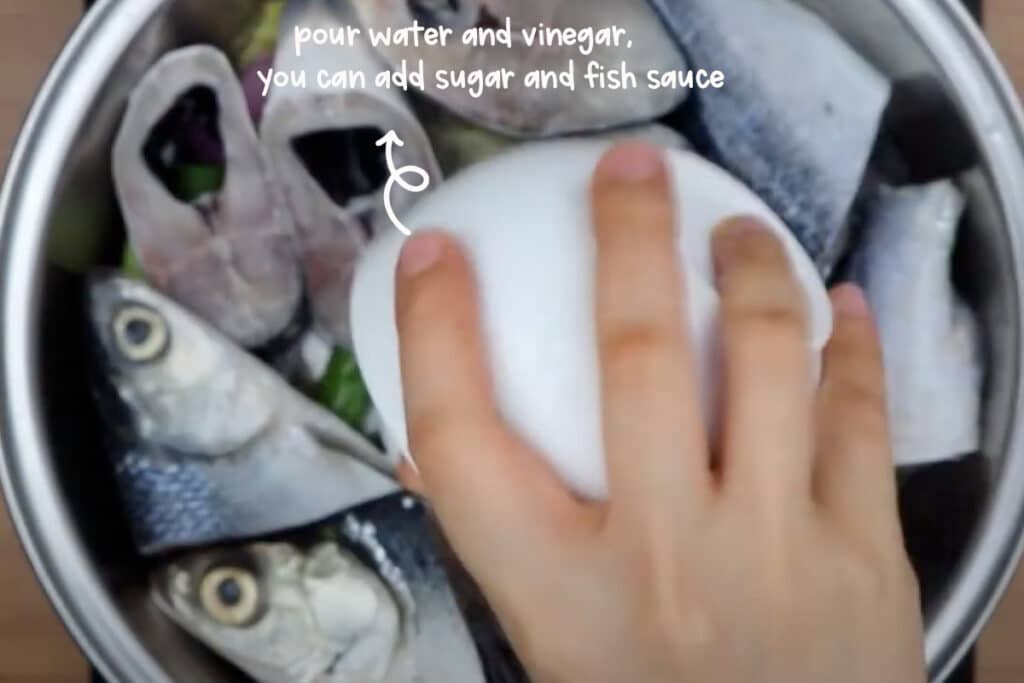
You can now pour the water and vinegar. Also, add some sugar and fish sauce; this makes paksiw tastier. A touch of sweetness balances the sour vinegar. The fish sauce provides the umami.
Step 5 Cook the fish.
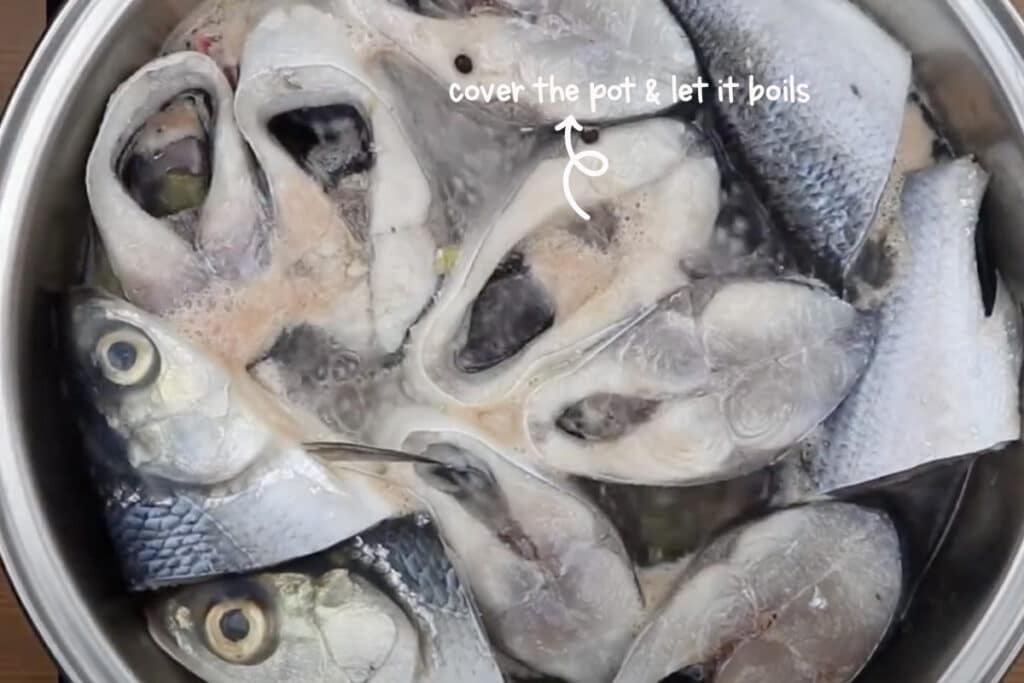
Cover the pot and let everything boil. Once boiling, lower to medium-low heat and let it cook for 15 minutes.
Important: Taste the sauce and adjust the seasoning if needed.
Step 6 Drizzle some oil

Drizzling some vegetable oil before the dish finishes cooking will bind the flavors. It will add richness to the sauce as well.
Serve with hot rice and some fried eggplant.
Recipe Notes:
- You can adjust vinegar to ¼ cup for a less sour version of paksiw. Or you can make it to ¼ cup cane vinegar and ¼ cup spicy white vinegar.
- You can use any vinegar: white wine vinegar, distilled vinegar, rice vinegar, and coconut vinegar. Manuka is a good brand.
Are there bones in the milkfish belly?
There are no bulky bones in the milkfish belly. This is because of the skeletal structure of the fish. Notice the color separation between the back and the stomach.
The fishmonger can follow this boundary. The fishmonger can remove the belly without bones by slicing along a curved arch.
Many people want the gelatinous deposit between the abdominal wall and the black cavity lining. The taste of this part is not fishy. It also has that delicious slippery mouthfeel.
What does milkfish taste like?
Milkfish are sweet and mild. It can match any ingredient. The texture of this fish suits most cooking styles.
You can barbecue, stew, and even stuff this versatile fish, and it's a perfect addition to soups. You can grill, bake, and fry them. Combining it with vinegar, spices, and ginger will not be a problem.
Trying your hand at other bangus-based dishes will not be a problem. Each one is delicious and easy to make. It is just a matter of finding the time to try them.
Why are they called milkfish?
These fish have flaky and white flesh. This fish is most certainly when cooked. The cooked flesh of bangus resembles the color of milk. That is why the locals call it milkfish.
Are milkfish good to eat?
Milkfish are high in nutrients as it contains omega-3 fatty acids. These fatty acids are vital in maintaining human heart health.
Bangus is bonier than other fish that humans eat. Its meat is tender. Its price is lower, so it is popular in Japan, the Philippines, and Hawaii island nations.
How to clean milkfish or bangus?
Remove the scales first. You can do this by rubbing your knife against the grain of the scales. Your regular fishmonger can do this for you.
Just tell them that you want the skin intact.
Step 1

Rinse the fish clean, then use a shear to snip all the fins from the body (plus the caudal flaps).
Clean the fish by removing the scales. Ensure that all scales have been removed by de-scaling the bangus again.
Step 2

Cut the skin underneath the head to reveal the gills. You can use your kitchen scissors for this. Grab the gills and pull them out of the head.
Step 3
Wear protective surgical gloves. Slit the belly and separate the stomach from the guts with your middle and forefinger. Pull the guts out.

Step 4
Clean out the stomach and rinse it with cold water.

Step 5
Once the milkfish is thoroughly cleaned, you can cut it according to your desired size.
Summary:
Knowing how to cook paksiw na bangus can benefit you when no one can cook, and you crave it. Bangus, or milkfish, is a versatile fish.
Paksiw is only one method of cooking it. You can bake, fry, grill, stew, and add it to your soup. This is a delicious and easy way to get your bangus fix.
The first step to accomplishing this dish is to clean it well; this includes de-scaling and de-gutting it. If you know how and have the time, you can do this in your kitchen with your knife and fish scaler.
You can also ask your fishmonger to do it for you. After this, you can start cooking your bangus whichever you like.
Full Recipe
Super Easy, Delicious Paksiw na Bangus
Pin RecipeEquipments:
- clay pot or stainless steel pot
Ingredients:
- 1 piece large Milkfish or Bangus (scaled and diagonally sliced into 5 slices)
Other Ingredients:
- 3 thumbs ginger (crushed)
- 6 cloves garlic (crushed)
- 1 piece onion (sliced)
- 2 pieces bay leaves
- 3 pieces green chili (or siling haba)
- 3 pieces okra (chopped)
- 1 piece eggplant (sliced)
- 1 piece bittermelon (or ampalaya) this is optional
- 1 cup water
- ½ cup white vinegar
- 1 teaspoon whole peppercorns
- 1 tablespoon sugar (optional)
- 2 tablespoon fish sauce
- 2 tablespoon vegetable oil (drizzled on top of the dish after the fish is cooked)
Instructions:
Step 1: Clean the Bangus well.
- If you’re pressed for time, you can ask your fishmonger to perform this crucial part of the recipe. The skilled and experienced fishmonger can de-scale, cut, and de-gut the fish you choose.
Step 2: Remove the gallbladder from inner belly
- This is essential. You can use the pointed part of your knife to accomplish this process. This part gives an unpleasant taste to the dish. Gently take it off and be cautious not to break it.
- Rinse the fish thoroughly and rub with salt all over. Rinse with cold running water.
- Slice the fish diagonally (about 5 pieces).
Step 3: Placing the ingredients in this order
- Arrange the other ingredients first ( place them at the bottom of the pan) to prevent overcooking the fish.
- Then, place the fish cuts on top of the ingredients and sprinkle ½ a teaspoon of salt
Step 4: Pour in the water and vinegar.
- You can now pour the water and vinegar. Also, add some sugar and fish sauce, this makes paksiw tastier. A touch of sweetness balances the sour vinegar. The fish sauce provides the umami.
Step 5: Cook the fish
- Cover the pot and let everything boil. Once it's boiling, lower to medium-low heat and let it cook for 15 minutes.
- Taste the sauce and adjust the seasoning if needed.
Step 5: Drizzle some oil
- Pouring vegetable oil before the dish finishes cooking will bind the flavors. It will add richness to the sauce as well. Serve with hot rice and some fried eggplant.
Notes:
Tips and techniques for making the paksiw
- It is a versatile recipe to add whatever vegetables you like.
- If you do not like the long chilis, you can omit them.
- Adjusting the amount of vinegar will give you different levels of sourness and flavor.
- You can choose the best type of vinegar you want for this dish.
- You can use another type of fish if you cannot access bangus or milkfish.
- Remember to use stainless steel or clay pots for this dish. Avoid aluminum ones. Vinegar is an acid. It could corrode the aluminum pot.
How to get rid of the fish aftertaste?
Unfortunately, some people dislike fish. The fishy aftertaste and odor are a turn-off. The main reason is that you should still know how to clean your fish of choice. You cannot remove all of the fishy aftertastes.But you can reduce it by following these steps:
- Washing the milkfish multiple times under tepid running water is essential in preparing the fish.
- Then, it would be best to pour a cup of vinegar and a handful of salt over the cleaned fish.
- Massaging the salt and vinegar solution into the fish will help remove its fishiness.
- You can adjust vinegar to ¼ cup if you want a less sour version of paksiw. Or you can make it to ¼ cup cane vinegar and ¼ cup spicy white vinegar.
- You can use any vinegar: white wine vinegar, distilled vinegar, rice vinegar, and coconut vinegar. Manuka is a good brand.
Nutrition Information:
Please note that all nutrition information are just estimates. Values will vary among brands, so we encourage you to calculate these on your own for most accurate results.

